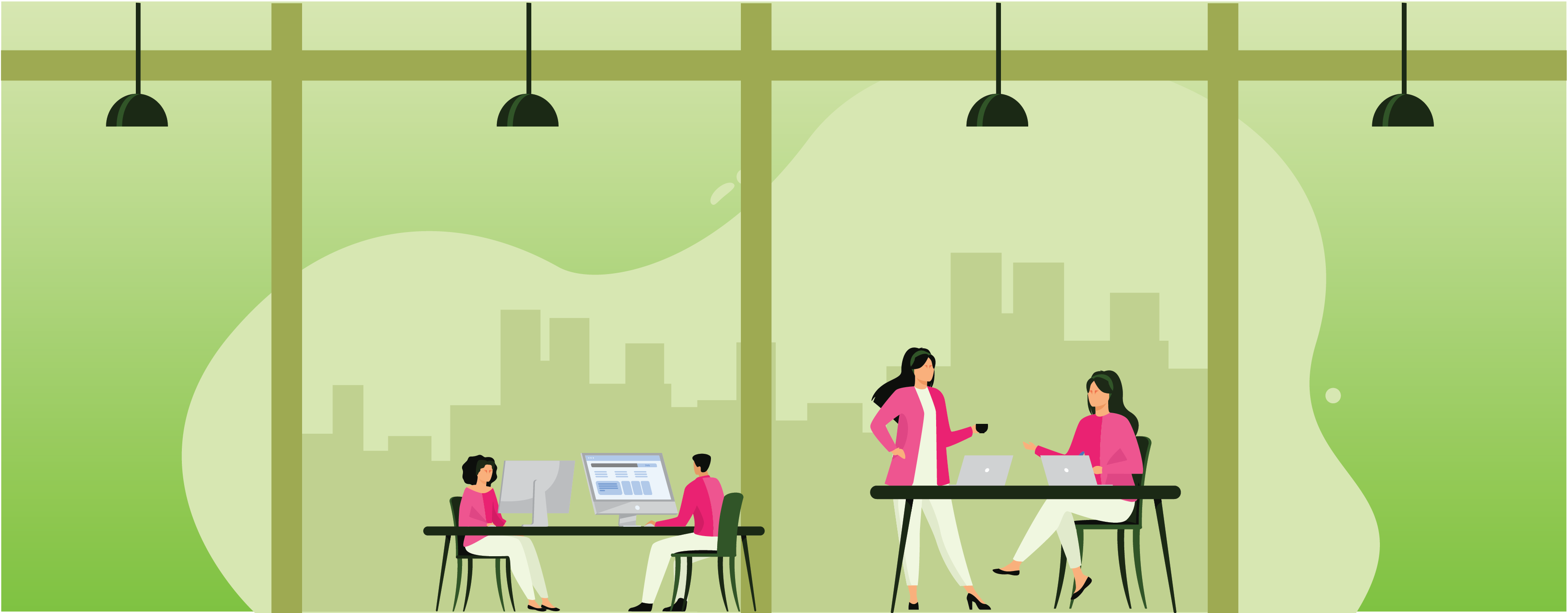
Lights, camera, action!
Setting up the office for maximal productivity
Imagine having to sit every day in a dark, cramped room with lots of noise and distractions. Sound dreadful? It is… or rather was. Luckily, corporations realised the importance of a comfortable workspace that promotes productivity. Open floor plans (more commonly known as Activity-Based Workspaces), bright coloured interiors and large windows are popping up increasingly in offices. In fact, almost 70% of employers have improved their physical environment to encourage healthy behaviours__¹__. What are the reasons behind this trend, should you follow it, and if so, how can you do it?
Workspace refers to the area required for one's work, usually an office or a home office. Two aspects significantly impact the workspace; the physical aspect and the soft aspect. Let's examine each in more detail.
The Physical Work Environment encompasses everything that you can see, touch, smell and taste. Essentially, this refers to lighting, colour, furniture etc. The Soft Work Environment refers to the intangible aspects of the work environment that can still impact your productivity, e.g. workload/working hours, frequency and timing of breaks, the flexibility of work practices, disruptions by co-workers, IT support and internet/computers/ software. Together, these make up the employee experience to their work environment.
So why has there been a focus on revolutionising the work environment in the past couple of decades? Well, a study of over 5,000 office workers (shown below) showed that activity-based workspaces ranked better in health, productivity and overall comfort of the working area__²__. The study compared three types of workspaces: Hive (large number of workstations are co-located in a large floor plate or booths), Cell (traditional cellular offices) and Activity-Based Workspaces (provides workers with spaces designed to help with different tasks such as quiet spaces, conference rooms, multimedia rooms, brainstorm areas and team desks). The results of this study are summarised in the graph below.

Let's dive deeper into the aspects that make up the physical work environment. The first is lighting and daylight. Daylight regulates our biological clock and our physiological processes. Good lighting helps us focus better and has a positive impact on mood. Multiple studies have shown that organisations that pay attention to improved lighting receive a higher level of productivity from their employees__³__. In fact, companies like Lockheed Martin reported a 15% decrease in absenteeism in buildings designed to provide maximum daylight for their occupants__⁴__.
Another aspect that falls within the visual spectrum is aesthetics. Good aesthetics are a pleasing feature in any environment. Various studies show that human performance is affected by colour schemes and the aesthetics of an indoor environment. Humans have built associations with different colours that provoke certain feelings. For example, blue reminds us of the ocean and the sky and evokes a sense of calmness, green reminds us of nature and instigates harmonious feelings. So it is important to develop a colour palette that not only reflects the organisation's brand but is also comfortable for the employees.
Biophilia (greenery and water features) are also a part of the aesthetics. Creating a more natural environment inside an office has a positive effect on the occupants' satisfaction by reducing stress. Additionally, it improves air quality. A study reports that absenteeism reduced by 10% due to the introduction of biophilia in the office environment__⁵__.
The next aspect is the temperature. The graph below shows the "sweet spot" for office temperature at around 22-23°C. A couple degrees up or down the scale, and performance drops by around 5%, but get down to 16-17 degrees, or up towards 30, and perfomance can drop 10-15%. That’s 300 hours of lost productivity per employee per annum, the equivalent of having nearly 2 months off work with pay!⁶.

Another major source that reduces productivity is noise. Noise is defined as unwanted sound and can come from traffic, air conditioning, co-worker chatter, office equipment etc. A study shows that an increase in a temperature change of 1°C has the same effect on productivity as a change in noise of 2.6 dB__⁷__. So while it is important to advocate discussion with an open floor plan, it is important to ensure that it does not become distracting and starts to impact productivity. A middle ground can be using proximity and partition measures.
The soft work environment is a vast area, and there is no "one-size-fits-all" for all aspects that fall within the category. The number of breaks or working hours that may work for the tech industry may hurt business in the agricultural sector. One unifying factor, however, is the IT support and computers/software etc. Wherever work requires internet or computers, poor wifi connection or old hardware can hurt productivity. So it is recommended that all IT needs to be checked and updated regularly to ensure the team has all the tools they need to do their job well. SHAPE analyses employee needs regarding IT and provides insights on where there is room to improve.
Office space is highly customisable. It should reflect the company's values and culture, but also make employees feel comfortable and maximise productivity. SHAPE helps identify how employees feel about their physical and soft work environment and what they think is hindering their productivity. With the help of the analysis, an ideal office environment that is aesthetically pleasing, calming and equipped with the tools required for the job can be created.
__¹__Behesti, Naz. 2019. "10 Timely Statistics About The Connection Between Employee Engagement And Wellness". Forbes.Com.
__²__Candido, Christhina, et al. 2016. Opus.Lib.Uts.Edu.Au.
__³__Papagiannidis, Savvas, et al. 2019. International Journal Of Information Management. doi:10.1016/j.ijinfomgt.2019.10.012.
__⁴__Al Horr, Yousef, et al. 2016. Building And Environment 105: 369-389. doi:10.1016/j.buildenv.2016.06.001.
__⁵__M.K. Elzeyadi, Ihab. 2011. Pdfs.Semanticscholar.Org.
__⁶__Papagiannidis, Savvas, et al. 2019. International Journal Of Information Management, 102027. doi:10.1016/j.ijinfomgt.2019.10.012.
__⁷__Al Horr, Yousef, et al. 2016. Building And Environment 105: 369-389. doi:10.1016/j.buildenv.2016.06.001.
